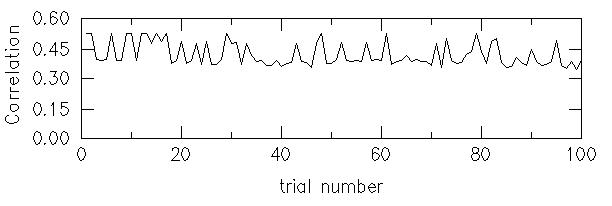
cns_solve < heavy_search.inp > heavy_search.out [49 minutes]
The beginning of the output file heavy_search.summary should be
looked at to check the input parameters. The 100
heavy-atom configurations found are stored in the files
heavy_search_*.sdb. A list of trial numbers and correlation
coefficients can be found in the file heavy_search.list.
Often it is useful to plot the list:

On Unix computers, the list file can easily be sorted.
sort +1n -r heavy_search.list
The beginning of the output shows that heavy_search_1.sdb is one of
the correct configurations.
+1 0.5279
+15 0.5279
+17 0.5279
+6 0.5279
+79 0.5279
+9 0.5279
+10 0.5278
+12 0.5278
+13 0.5278
+2 0.5278
+29 0.5278
+48 0.5278
+61 0.5278
73 0.5001
83 0.5000
95 0.4937
...
To aid the interpretation of the distribution of the
correlation coefficients, trials with a correlation coefficients
greater than 1.5 sigma of all trials are flagged with a plus sign.
The configuration corresponding to the top of the sorted list, heavy_search_1.sdb, can be used in the predict_patterson.inp task file for visual comparison of the observed and calculated Patterson maps (see previous tutorial), and as input for refinement of the heavy-atom parameters and computation of experimental phases (see following tutorials).